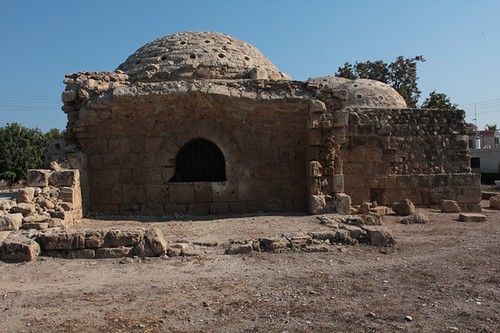In this post I'm going to talk about the “archeological Paphos”. What does it means? I'll tell you: one thing that I noticed and that struck me a lot is the amount of archaeological remains that we are in this city. Turkish bath of the Ottoman age, amphitheater of the Hellenistic period and tombs of various period of history, which are directly accessible from the street.
One thing that impressed me a lot of this city, perhaps the thing that struck me the most, is the amount of archaeological remains that are found in this city: a turcho Ottoman-era baths, amphitheatres and tombs of the Hellenistic period directly accessible from the road. All visible without any entrance fee (or "free offer") you can find these remains just walking along the streets. However, because there is a but, there are absolutely no descriptions that tell us what we're looking at, except in rare cases (for example, the column of St. Paul and the Monastery of Chrysorrogiatissa).
You can try to figure out what you are looking at using a tour guide (me and my mom had the Lonely Planet guide of Cyprus), but it is not at all simple.
Precisely for this reason I admit to not knowing how to give a precise path to follow to see all these things, but I can tell you what you can find wandering the streets of this village in Cyprus, in addition to all this, it also shows signs of the crisis that hit countries of Greece a few months ago (as he told an Italian girl I met them, it seems a carnival in bankruptcy).
Let's start with the remains of a Roman amphitheater: I have not found the entrance, so I took the pictures from behind a sort of fence that separate it from the road

Near this site, there are Turkish baths from the Ottoman era: you can't get in, but you can peek inside.

We continue with the column of St. Paul and the Monastery of Chrysorrogiatissa, that are near, one facing the other. This is the place where, according to the story, Saint Paul was flogged before starting the evangelization of the area.

There are, between the column and the monastery, the remains of several columns. We could not enter the building because of a function (the thing that we immediately noticed, standing in the doorway, was, in addition to the interior, the voice of woman holding the function: there're used to that!).

Then there are the (small) Catacombs of Solomon. These are marked with a (small) sign, just because small, it is difficult to notice

Then we come across in some caves. We imagined that these were tombs, also on the basis of what the guide said. Unfortunately, due to the fact that things are marked bad (or not) we had to go for exclusion :)


The fact that these sites are pretty much left to themselves struck me very much! The town of Paphos is practically an open-air archaeological site that should be taken care of! There is, in these remains, so much (too much) history that should be preserved, because it can then be told to future generations.
 Near this site, there are Turkish baths from the Ottoman era: you can't get in, but you can peek inside.
Near this site, there are Turkish baths from the Ottoman era: you can't get in, but you can peek inside.
 We continue with the column of St. Paul and the Monastery of Chrysorrogiatissa, that are near, one facing the other. This is the place where, according to the story, Saint Paul was flogged before starting the evangelization of the area.
We continue with the column of St. Paul and the Monastery of Chrysorrogiatissa, that are near, one facing the other. This is the place where, according to the story, Saint Paul was flogged before starting the evangelization of the area.
 There are, between the column and the monastery, the remains of several columns. We could not enter the building because of a function (the thing that we immediately noticed, standing in the doorway, was, in addition to the interior, the voice of woman holding the function: there're used to that!).
There are, between the column and the monastery, the remains of several columns. We could not enter the building because of a function (the thing that we immediately noticed, standing in the doorway, was, in addition to the interior, the voice of woman holding the function: there're used to that!).
 Then there are the (small) Catacombs of Solomon. These are marked with a (small) sign, just because small, it is difficult to notice
Then there are the (small) Catacombs of Solomon. These are marked with a (small) sign, just because small, it is difficult to notice
 Then we come across in some caves. We imagined that these were tombs, also on the basis of what the guide said. Unfortunately, due to the fact that things are marked bad (or not) we had to go for exclusion :)
Then we come across in some caves. We imagined that these were tombs, also on the basis of what the guide said. Unfortunately, due to the fact that things are marked bad (or not) we had to go for exclusion :)

 The fact that these sites are pretty much left to themselves struck me very much! The town of Paphos is practically an open-air archaeological site that should be taken care of! There is, in these remains, so much (too much) history that should be preserved, because it can then be told to future generations.
The fact that these sites are pretty much left to themselves struck me very much! The town of Paphos is practically an open-air archaeological site that should be taken care of! There is, in these remains, so much (too much) history that should be preserved, because it can then be told to future generations.
Nessun commento:
Posta un commento